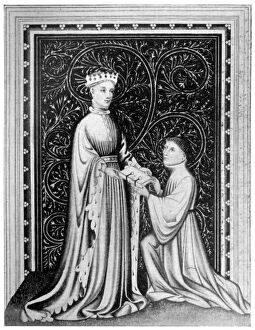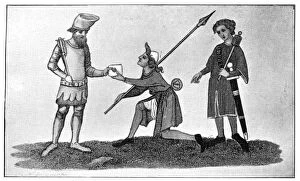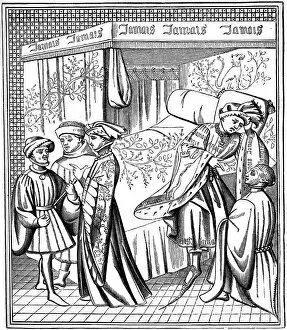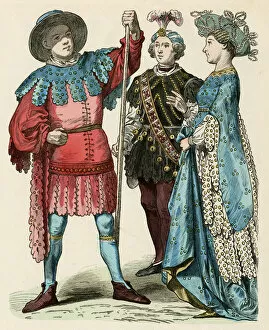Dagging Collection
"Dagging: Unveiling the Artistic Flourish of Medieval Fashion" Step into the world of medieval fashion with a glimpse into the past
For sale as Licensed Images
Choose your image, Select your licence and Download the media
"Dagging: Unveiling the Artistic Flourish of Medieval Fashion" Step into the world of medieval fashion with a glimpse into the past. From the 14th to 15th century, dagging was an intricate and captivating technique that adorned garments with decorative edges. The paltock, a popular outer garment in the 14th century, showcased exquisite dagged trims that added flair to its design. French Costumes from 1460-80 also embraced this trend, as seen in their elaborate ensembles. Even renowned figures like Occleve, a poet of his time, and King Henry V himself were not immune to the allure of dagging. Their attire from around c1410 boasted stunning details created by skilled craftsmen who mastered this art form. Male dress during this era was no exception when it came to embracing dagging's charm. In fact, male costumes from the 14th century often featured intricately patterned houppelandes with eye-catching daggered edges that elevated their style. The versatility of houppelandes is evident through various examples found throughout history. These flowing garments were tailored differently based on personal preferences and social status - each one showcasing unique patterns and designs while maintaining their signature daggered embellishments. Delving deeper into medieval aesthetics reveals fascinating glimpses into cultural narratives such as "The Red And White Roses" painting from the 15th century or a bed furnished with a canopy and curtains dating back to late 14th-century opulence. Entertainment during these times also incorporated dagged costumes; three minstrels depicted in c1480 exemplify how even performers used fashion as an artistic expression for visual impact. One cannot overlook how sleeves evolved during this period either. Development of sleeve styles in the 15th century witnessed innovative use of dagged trims which transformed ordinary sleeves into extraordinary works of art. Dagging became synonymous with the fashion of the era, leaving an indelible mark on history.











